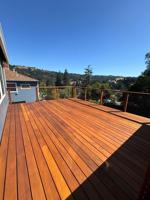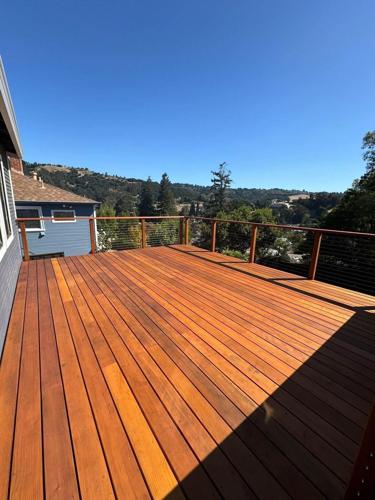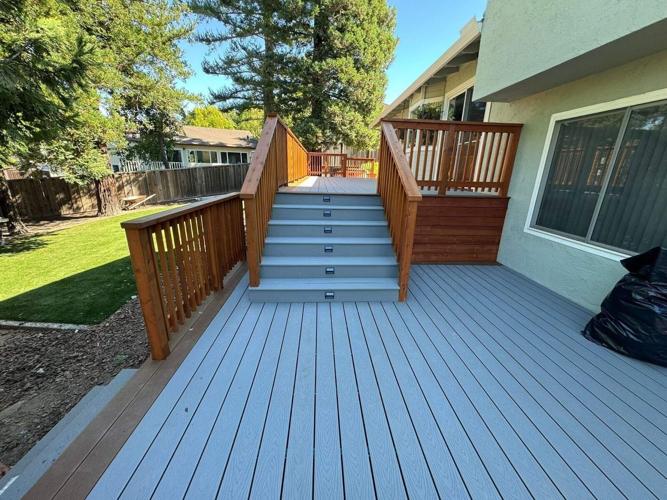Choosing the best decking material depends on your budget, climate, and desired aesthetic. Options like wood, composite, PVC, and aluminum each offer unique benefits, from natural beauty to low maintenance and durability. In this article, we’ll break down the pros and cons of each material to help you make the best choice for your outdoor space.
Remember, your deck is an investment, and selecting the right material ensures it will stand up to weather, wear, and your lifestyle. Whether you prioritize a classic look, minimal upkeep, or long-term durability, understanding the strengths and weaknesses of each option is key.
Let’s explore the top decking materials to help you create a functional and beautiful outdoor area tailored to your needs.
Wood Decking: Classic and Natural
Wood decking is a timeless choice. It offers a warm, natural look that blends seamlessly with outdoor environments.
Popular wood options include pressure-treated pine, cedar, redwood, and tropical hardwoods like ipe. If you're designing for high foot traffic areas, hardwoods like ipe offer exceptional durability and longevity.
Each type varies in durability, cost, and maintenance needs, so choose based on your budget and climate.

Pressure-treated pine is affordable and widely available, making it a popular choice for many homeowners. Cedar and redwood are naturally resistant to rot and insects. They also provide a more premium appearance.
Meanwhile, tropical hardwoods, like ipe, are extremely durable but come with a higher pricetag.
Whichever wood you choose, regular sealing and staining is essential to protect the wood from moisture, UV rays, and wear.
To maintain wood decking, clean it annually with a wood cleaner and inspect for splinters, cracks, or rot. Sand rough areas and reapply sealant or stain every 1-3 years to keep it looking fresh.
Lastly, do not let water pool on the surface, as this can lead to warping or decay. With proper care, wood decking can last for decades while maintaining its natural beauty.
Composite Decking: Low-Maintenance and Durable
Composite decking has become a popular choice for homeowners seeking a balance of durability and low upkeep. Made from a blend of wood fibers and recycled plastics, it mimics the look of wood without the high maintenance. It’s an excellent option for those who want a long-lasting deck with minimal effort.
Durability: Resistant to rot, insects, and fading, composite decking stands up to harsh weather and heavy use. It doesn’t splinter or warp like traditional wood, making it a safer and more reliable option.
Low Maintenance: Unlike wood, composite decking doesn’t require sealing, staining, or painting. Occasional cleaning with soap and water is all it needs to stay looking new.
Eco-Friendly: Many composite materials are made from recycled products, reducing waste and offering a more sustainable choice for environmentally conscious homeowners.
While composite decking has a higher upfront cost than wood, its longevity and minimal maintenance needs make it a cost-effective choice in the long run. If you want a deck that looks great year-round with little effort, composite is a smart investment.
PVC Decking: Weather-Resistant and Long-Lasting
PVC decking is a fully synthetic option made from 100% plastic. This material is highly resistant to moisture, mold, and insects. It’s an ideal choice for humid or wet climates where traditional wood might struggle. Since it has no organic materials, PVC won’t rot, warp, or splinter over time.
One of the biggest advantages of PVC decking is its low maintenance. It doesn’t require sealing, staining, or painting. Simply clean it with soap and water to remove dirt and stains.
Its non-porous surface also prevents mold and mildew buildup, keeping it looking new with minimal effort.
When installing PVC decking, ensure proper spacing between boards to allow for expansion and contraction in extreme temperatures. Avoid using harsh chemicals or abrasive tools during cleaning, as they can damage the surface.
PVC decking is a bit more expensive upfront, but its durability and ease of care make it a decent investment for a long-lasting, weather-resistant deck.
Aluminum Decking: Lightweight and Modern

Aluminum decking is a sleek, modern option that’s gaining popularity for its durability and unique aesthetic. Made from lightweight yet strong materials, it’s resistant to rust, fire, and extreme weather conditions. This makes it an excellent choice for homeowners looking for a contemporary, low-maintenance deck.
Durability: Aluminum is impervious to rot, insects, and moisture, lasting decades without degradation. It’s also fire-resistant, adding an extra layer of safety.
Low maintenance: Unlike wood or composite, aluminum requires no sealing, staining, or painting. Occasional cleaning with mild soap and water is all it needs to maintain its appearance.
Eco-friendly: Aluminum is a sustainable choice for environmentally conscious homeowners since the material is recyclable. Its reflective surface also stays cooler underfoot compared to other materials.
If you’ve ever walked barefoot on a scorching wooden deck in the summer, aluminum decking might feel like a breath of fresh air — literally. While aluminum decking is more expensive upfront, its longevity and minimal upkeep make it a cost-effective option over time.
Choosing the Right Material for Your Climate
Selecting the right decking material depends heavily on your local weather.
Hot, dry areas benefit from materials that resist cracking and fading, like composite or aluminum. Humid regions call for moisture-resistant options like PVC or composite.
For mixed climates, composite offers a versatile solution that balances durability and aesthetics. If you're planning a deck replacement in an area with mixed weather, composite materials can provide long-term performance with minimal maintenance.
Therefore, consider how much sun, rain, and snow your deck will face year-round. A little planning now can save you a lot of repairs (and headaches) down the road.
Budget and Aesthetic Considerations
Balancing cost and style is key when choosing decking materials. Your budget will guide your options, but it's important not to compromise on quality or design. Focus on materials that align with both your needs and personal taste.
Set your budget range: Decide how much you're willing to spend before shopping. This helps narrow down your choices.
Prioritize quality over quantity: Investing in fewer, high-quality pieces often saves money in the long run.
Match style to your space: Choose colors, textures, and designs that complement your existing decor.
Plan ahead to identify options that meet both your financial limits and aesthetic preferences for your outdoor space. Thoughtful choices create a cohesive, lasting look and prevent your deck from becoming that one unfinished DIY project your neighbors gossip about.
The best decking material for you depends on your budget, climate, and desired aesthetic. You can choose between wood, composite, PVC, and aluminum, but understand that each option offers unique benefits to suit different needs and preferences.
Consider factors like durability, maintenance, and long-term value, to make an informed decision that enhances your outdoor space.
Take the time to evaluate your priorities and explore the pros and cons of each material. With the right choice, your deck will not only look great but also stand the test of time. Start planning today and create a deck that’s perfect for your lifestyle and home.











(0) comments
We welcome your comments
Log In
Post a comment as Guest
Keep it Clean. Please avoid obscene, vulgar, lewd, racist or sexually-oriented language.
PLEASE TURN OFF YOUR CAPS LOCK.
Don't Threaten. Threats of harming another person will not be tolerated.
Be Truthful. Don't knowingly lie about anyone or anything.
Be Nice. No racism, sexism or any sort of -ism that is degrading to another person.
Be Proactive. Use the 'Report' link on each comment to let us know of abusive posts.
Share with Us. We'd love to hear eyewitness accounts, the history behind an article.